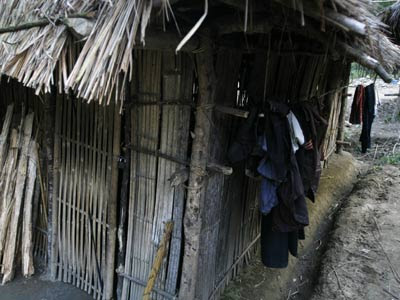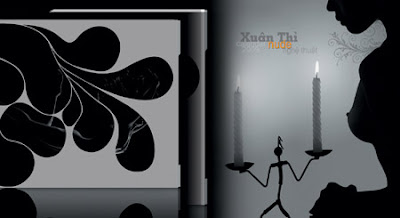ExhibitionsHanoiMaison Des Arts31A Van Mieu St, Tel: 7478096
- Photos, paintings, video & sculpture exhibition entitled Long Bien Bridge's Memory, till Oct 11.
Exhibition House29 Hang Bai St.
- Japan - The Country of Cherry Blossoms photo exhibition by veteran photographer Le Vuong and Vietnamese Ambassador to Japan, Nguyen Phu Binh, till Sep 16.
Ho Chi Minh CityCao Gallery80 Pasteur St., Dist 1.
- Exclusive collection of contemporary art, open daily.
Tu Do Gallery53 Ho Tung Mau St., Dist 1.
- Contemporary paintings, daily 9am-7pm.
Thien Van Stone Gallery6 Ba Huyen Thanh Quan St., Dist 3.
Collection of precious stones including rubies, sapphires, emeralds, topaz, zicon and jade on display and for sale, open daily.
PerformancesHanoiHa Noi Opera House
1 Trang Tien St, Tel: 9330131 ; 5651806
- Night of autumn classical ballet entitled Chopinian and Firebird, with choreographer F.Chopin & Lars Andersen and the dancers of Viet Nam National Opera and Ballet, at 8pm, Sep 15 & 16.
- Autumn concert, conductor Wang Ya Hui, violin soloist Nguyen Cong Thang, oboe soloist Phan Viet Cuong and the Ha Noi Philharmonic Orchestra, at 8pm, Sep 21.
- Symphony concert, conductor Tetsuji Honna, solo alto Anna Einarsson with Viet Nam Symphony Orchestra, at 8pm, Sep 22 & 23.
- Korean Chorus, combination of German Classics and Korean Songs echoed in a church hail performed by the Seoul motet Choir, at 8pm, Sep 25.
All tickets available at the Ha Noi Opera House or book at www.ticketvn.com. or 0913489858
Thang Long Water Puppet Theatre57B Dinh Tien Hoang St,
Tel: 8220268
Water puppet extracts at 4pm; 5.15pm; 6.30pm; 8pm; 9.15pm. Tickets: VND20,000-40,000.
Viet Nam Museum of EthnologyNguyen Van Huyen Rd.,
Tel: 7562193
- Ca Tru performance on the fourth Sun of month.
- Water puppet performance at 10am; 11.30am; 2.30pm; 4pm. Tickets: VND10,000-20,000.
National Circus Theatre67-69 Tran Nhan Tong St.
Tel: 8220277
Shows at 10am, 8pm everyday. Tickets: VND40,000-50,000.
Ha Noi Cheo Club15 Nguyen Dinh Chieu St.
Tel: 9437361
Vietnamese popular opera accompanied by traditional orchestra. Performances on Mon & Fri at 8pm. Ticket price at VND50,000.
Viet Nam Tuong Theatre51 Duong Thanh St,.
Tel 8287268
Five scenes from traditional Tuong plays, at 5pm, Wed & Thu. Ticket prices at VND50,000.
Sofitel Metropole Hanoi Hotel15 Ngo Quyen St. Tel: 8266919
Le Club Bar
- French singer Nadia Cambours' jazz repertoire from the 1920s and 30s, every Tue-Sun, till Oct 22.
Ho Chi Minh CityHCM City Labour Cultural Palace55B Nguyen Thi Minh Khai St, Dist 1.
Water puppetry performance, 6.30pm and 8pm, Sat & Sun.
Caravelle Hotel: Sai Gon Sai Gon Bar19 Lam Son Sq, Dist 1,
Tel: 08 8234999
- Live music 8pm onwards.
- Performance by the Latino band Badneighbours, every Mon night.
Majestic Hotel1 Dong Khoi St., Dist 1.
M-Bar- Live music entertainment by the Filipino band 8.30pm-11pm.
Catinat- Romantic piano music with cocktails&soft drinks, noon-7pm.
Sheraton Sai Gon Hotel & Towers88 Dong Khoi St., Dist 1.
Tel: 8272828
Nightspot- Live music by the Canadian band Saint O, 8.30pm onwards, Tue-Sat.
CinemasHanoiMegaStar Cineplex
191 Ba Trieu St,
Tel: 9743333
Photo: Internet
- Run Papa Run (China, OV)
- Death Race (US, OV)
- Vantage Point (US, OV)
- Mamma Mia (US, OV)
- The Good, the Bad, the Weird (US, OV)
- The Dark Knight (US, OV)
- Wall-E (US, OV)
- The Mummy 3: Tomb of the Dragon Emperor (US, OV), till Sep 18.
National Cinema Centre87 Lang Ha St,
Tel: 5141791
- Run Papa Run (China, OV), till Sep 18.
- Death Race (US, OV), till Sep 18.
- Vantage Point (US, DV), till Sep 18.
- Mamma Mia (US, DV), till Sep 18.
- The Dark Knight (US, DV), till Sep 18.
- The Mummy 3: Tomb of the Dragon Emperor (US, DV), till Sep 18.
Dan Chu Cinema211 Kham Thien St,
Tel: 8516702
- Mamma Mia (US, OV), till Sep 18.
- The Dark Knight (US, DV), till Set. 18.
August Cinema45 Hang Bai St,
Tel: 04 8253911
- The Dark Knight (US, DV), till Set. 18.
- Vantage Point (US, DV), till Sep 21.
- Blonde Ambition (US, DV), Sep 19-21.
- Prom Night (US, DV), Sep 19-21.
Ngoc Khanh Cinema521 Kim Ma St,
Tel: 7712750
- Run Papa Run (China, OV)
- The Mummy 3: Tomb of the Dragon Emperor (US, DV)
- The Triangle (US, DV)
- The Good, the Bad, the Weird (US, DV), till Sep 18.
Ho Chi Minh CityGalaxy Nguyen Du Cinema116 Nguyen Du St, Dist 1,
Tel: 08 8235235
- Vantage Point (US, OV)
- The Dark Knight (US, OV)
- Death Race (US, OV), till Sep 19. Buy-one-get-one every Tue.
Galaxy Nguyen Trai Cinema230 Nguyen Trai St, Dist 1,
Tel: 9206688
- Death Race (US, OV)
- The Dark Knight (US, OV)
- Vantage Point (US, OV), till Sep 19. Buy-one-get-one every Tue&Wed.
Megastar Cineplex Hung Vuong126 Hung Vuong Dist 5.
Tel: 2220388
- Vantage Point (US, OV)
- The Good, the Bad, the Weird (US, OV).
- Wall-E (US, OV)
- Mamma Mia (US, OV)
- The Mummy 3: Tomb of the Dragon Emperor (US, OV)
- The Dark Knight (US, OV)
- Death Race (US, OV)
- Mr. Woodcock (US, OV)
- Spiderman 3 (US, OV)
Dining OutHanoiInterContinental Hanoi Westlake1A Nghi Tam St., Tay Ho Dist; Tel: 2707047
Cafe du lac
- Contemporary French brasserie: breakfast, lunch, dinner. Buffet set menu & a-la-carte, daily 6am to midnight.
- Seafood dinner buffet, every Fri, 6pm-10.30pm.
- Sunday Brunch, 11.30am-3pm
Le Gourmet
- International and local breads, pastries and cakes.
Milan-Saigon
- Italian and Asian foods. Dinner from 6pm-10.30pm.
Diplomat Lounge
- Open from 10.30am-11pm. Happy hours nightly.
Hilton Hanoi Opera Hotel1 Le Thanh Tong St,
Tel: 9330500/550
1/Chez Manon
- Germany and Pacific Rim Wine Flight menus, available for lunch & dinner, 4-course set menu matched with 3 regional wines.
- Sparkling Sunday Jazz Brunch, from 11.30am-3pm.
- Opera Terrace BBQ, every Sun, from 3pm-9pm.
- Oktoberfest: Traditional German buffet and girl at $26++; German beer and wine buffet at $18++.
2/Ba Mien
- Vietnamese Wine Flight menu.
- 60-Minute Business Lunch, Mon-Fri.
- Moon Festival Menu: 4-course set menu.
3/JJ's Sports Bar
- Weekend Pizza Party, Fris & Sats.
4/Lobby Lounge
- 19 Wine Buffet with live musical entertainment from 5.30pm-10.30pm.
- Wine Flight Teaser menu - a selection of appetisers, main course and desserts, daily.
Thang Long Opera Hotel1C Tong Dan St. Tel: 8244775
- Lunch buffet, Mon-Fri.
- Vietnamese a-la-carte and set menus for dinner.
Hanoi Daewoo Hotel360 Kim Ma Rd, Tel: 8315000
1/ Cafe Promenade
- Weekend BBQ buffet, Fri-Sat.
2/ La Paix
- Business Lunch set menu.
- Daewoo Pizza at $9net.
3/ Edo
- Weekend dinner buffet with a large selection of Japanese dishes.
4/ Silk Road
- New a-la-carte menu.
- New dim sum lunch buffet.
- Chef's Recommendation menu.
5/ Lake View
- A wide selection of beverage, coffee, drinks.
6/ Le Gourmet
- Freshly baked bread, pastries, cookies, chocolates ad gourmet specialities.
Ho Chi Minh City Parkroyal Saigon Hotel: Garden Brasserie309B-311 Nguyen Van Troi St, Tan Binh Dist, Tel: 8421111
- Singapore food promotion featuring delectable buffet delights, fresh seafood & New Zealand beef and lamb for lunch & dinner. Sep 15-21.
- Buffet featuring Asian & Western cuisine with daily changes of menu for breakfast, lunch & dinner, daily at 5am-10am, 11.30am-2.30pm & 6pm-10pm.
Sheraton Sai Gon Hotel & Tower88 Dong Khoi St, Dist 1, Tel: 8274002
Sai Gon Cafe
- Enjoy international dinner buffet with delectable dishes including seafood and grilled meats, daily 6pm-10pm.
Li Bai
- Asian Sunday dinner buffet with aromas and exotic flavours of Asian cuisine, every Sun, 6pm-10pm.
- Set menus and "Wines of the World" for dinner, 6pm-10pm, till Oct.
New World Hotel Sai Gon76 Le Lai St, Dist 1, Tel: 8230710
Parkview Restaurant
- International buffet for breakfast, lunch & dinner, with a variety of specialities & premium wines across the world.
Barbecue Garden135A Nam Ky Khoi Nghia St, Dist 1, Tel: 8233340
- BBQ specialties with over 60 dishes of Vietnamese and international recipes, daily 7am-11pm.
- Set menus for daily breakfast and lunch.
Ming Dynasty Restaurant23 Nguyen Khac Vien St, Dist 7. Tel: 4115555
- Authentic Chinese cuisines: breakfast, lunch and dinner.


















































